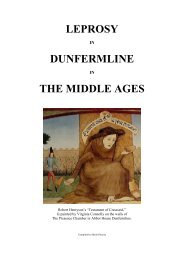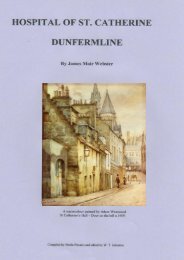Charlestown kilns to three piers, first of all narrow rails for hutches, and then wider ones for wagons which brought it to the near approaches of the harbours. In very early time, of course, it was conveyed to them in wagons drawn by horses. <strong>The</strong>re are still to be seen the old stables at Charlestown opposite the „Sutlery‟ (now Mr. Baxter‟s grocer‟s shop and post-office), where Lord Elgin‟s horses were kept for this purpose. It was horse-haulage, too, and not rope-haulage from the quarries to the kilns in 1760. In the sixties of last century the Charlestown and <strong>Dunfermline</strong> Railway took over most of the transportation of lime, and by 1870 we might say that shipping from Limekilns and Brucehaven received its death-blow, though it lingered on from Charlestown for a time. PLATE V Brig ‘Jessie Thoms’ of Limekilns (Captain John Monro) Entering <strong>The</strong> Harbour of Malta, 1854. 24
Having alluded to the Rev. William Johnston, it may be mentioned here that it was he who, in 1852. „joined in holy matrimony,‟ and in the old Scottish way – in the house – Mr. Andrew Barclay Walker (afterwards knighted, and created a Baronet in 1886 – father of the future Lord Wavertree) and Miss Elizabeth Eliza Reid, eldest daughter of Captain John Reid, shipmaster and ship-owner, of „<strong>The</strong> Hollies.‟ A portrait of the latter, showing a middle-aged man with fresh complexion and black hair, and whiskers of the Victorian era, hangs in the dining-room of „<strong>The</strong> Hollies.‟ Mr. Reid was married to a daughter of Captain John Monro, another Limekilns ship-master, whose name was well known in shipping circles on the Forth. Captain Reid is still remembered with affection by many of the older people, who were also much attached to his daughter, Miss Joanna Reid, for long resident at „<strong>The</strong> Hollies.‟ She died in Edinburgh in 1920, and was laid to rest in the old burying-ground of Rosyth Church, where many of her relatives, the Andesons, Reids, and Monros, have been interred for a century back and more. Another of his daughters, Isabella, married her first cousin, Mr. James Monro, who died in 1926. Captain John Monro (Lord Wavertree‟s great-grandfather) had two sons, Andrew and Robert, who, following in their gather‟s footsteps, became great seafaring people and made voyages to many parts of the world in their own sailing vessels. Andrew Monro himself sailed a brig, Jessie Thoms (built at Dundee), round the Cape of Good Hope to Saldanha Bay, and also round Cape Horn to Valparaiso. All three of them would sail from Limekilns to Russia, Norway, and Sweden, and to the ports in Denmark, Holland, Belgium, France, and into the Mediterranean. Mrs. James Monro has several exceedingly interesting pictures of vessels which belonged to the family, including the Cicerone, lost in the Baltic, Jessie Thoms, Nellys and Betty, and the John Monro. All but the first named are herein reproduced, together with the Sir Walter Scott, a Limekilns sloop which carried passengers and goods even after paddle-steamers entered into direct competition. And often she completed her voyage when the steamer was compelled to take shelter from the gale. <strong>The</strong> John Monro belonged to Captain John‟s son Robert, and was lost off the east coast during a heavy easterly gale. Her sails were torn to rags, and she drove on to the banks, where she went to pieces. <strong>The</strong> crew all perished except Captain Monro, who was found next day insensible, lashed to a floating spar. He recovered and lived for many years afterwards at Limekilns. But of the collection, the large water-colour of Nellys and Betty is most appealing to the eye: besides being accurately drawn, there is something in the composition of the picture which readily takes one back to the eighteenth century. She was built at Limekilns for Mr. John Anderson, shipmaster, who purchased the old red-tiled cottage behind and now connected with „<strong>The</strong> Hollies,‟ and probably built „<strong>The</strong> Hollies‟ itself. John Anderson married Helen Wyld, who belonged to an Irish 25
- Page 2 and 3: REPRINT ON DISC 2013 ISBN 978-1-909
- Page 4 and 5: PLATE I THE BAY, LIMEKILNS. 4
- Page 7 and 8: CONTENTS 7 PAGE CHARPER I. INTRODUC
- Page 10 and 11: Drawn by Herry-Perry, and finished
- Page 12 and 13: Limekilns once was prosperous, and
- Page 14 and 15: not have wished for a more peaceful
- Page 16 and 17: There is still much of the seventee
- Page 18 and 19: PLATE IV ANCIENT DOORWAY AT LIMEKIL
- Page 20 and 21: orn here in 1757. He was the son of
- Page 22 and 23: CHAPTER II. HARBOURS, SHIPS, SHIPMA
- Page 26 and 27: family, several of whom came over t
- Page 28 and 29: was opened again, allowing the wate
- Page 30 and 31: PLATE VII TWO EXACT VIEWS OF THE
- Page 32 and 33: Industry of Mannor. Port. Happy Ret
- Page 34 and 35: Lime Works‟ and bears the inscrip
- Page 36 and 37: operated by a rakish, if rather thi
- Page 38 and 39: CHAPTER IV; LANDOWNERS AT LIMEKILNS
- Page 40 and 41: „Ane Procuratarie granted to Jame
- Page 42 and 43: PLATE IX A LIMEKILNS SLOOP, THE ‘
- Page 44 and 45: CHAPTER V: LANDOWNERS AT LIMEKILNS
- Page 46 and 47: The name Pitfirrane is derived from
- Page 48 and 49: PLATE X A TOP CORNER OF PITFIRRANE
- Page 50 and 51: The latter picture, which shows the
- Page 52 and 53: in 1274, succeeded his father as 2n
- Page 54 and 55: Thereafter the title was held in su
- Page 56 and 57: PLATE XI LIMEKILNS HARBOUR (Circa 1
- Page 58 and 59: Harmodios and Aristogeiton.‟ This
- Page 60 and 61: During the latter half of his sojou
- Page 62 and 63: of the Government of that period. M
- Page 64 and 65: 1791 to the present Bruce line by M
- Page 66 and 67: middle which carried him close unde
- Page 68 and 69: PORTRAIT OF THE RIGHT HON. LORD WAV
- Page 70 and 71: Herring, Seymour, George Stubbs, et
- Page 72 and 73: something on the skull; and on furt
- Page 74 and 75:
had neer fed anything before and th
- Page 76 and 77:
Small beginnings, then have had gre
- Page 78 and 79:
CHAPTER VIII: THE BROOMHALL, ‘DOO
- Page 80 and 81:
udely carved stone, like a metope f
- Page 82 and 83:
The new church, built to replace an
- Page 84 and 85:
This „glimpse of the ecclesiastic
- Page 86 and 87:
„1650. 29 Jan.: That day comperit
- Page 88 and 89:
CHAPTER IX: ‘THE KING’S CELLAR
- Page 90 and 91:
PLATE XVI KINGS’S CELLAR, LIMEKIL
- Page 93 and 94:
PLATE XVII are fairly regular throu
- Page 95 and 96:
years earlier. Mr. Deas thinks that
- Page 97 and 98:
CHAPTER X: PASSAGIUM REGINAE The tr
- Page 99 and 100:
the Romans‟ advantage the whole o
- Page 101 and 102:
and galloping off in search of food
- Page 103 and 104:
We do know, however, that after the
- Page 105 and 106:
„And in that ancient, plaintive S
- Page 107 and 108:
at Inverkeithing to be in readiness
- Page 109 and 110:
There are to be found many passages
- Page 111 and 112:
of Leith Street on the west side, n
- Page 113 and 114:
If Scotland was under an obligation
- Page 115 and 116:
St Andrews Square. Edinburgh may th
- Page 117 and 118:
Brighton and saw my friends take th
- Page 119 and 120:
length and took twenty minutes to p
- Page 121 and 122:
APPENDIX Note I. (see p.2). - The p
- Page 123 and 124:
5th Earl of Elgin, previous at leas
- Page 125 and 126:
„Mackintosh seized Leith citadel
- Page 127 and 128:
- Robert 1st Baron of Skelton (d.11
- Page 129 and 130:
Elgin Mary, Countess of (neé Nisbe
- Page 131 and 132:
Laing Charters, Calendar of the, 40
- Page 133 and 134:
„Raider,‟ foxhound, 70. San Mig
- Page 135:
Wemyss, Francis, 6th Earl of, 47. -




